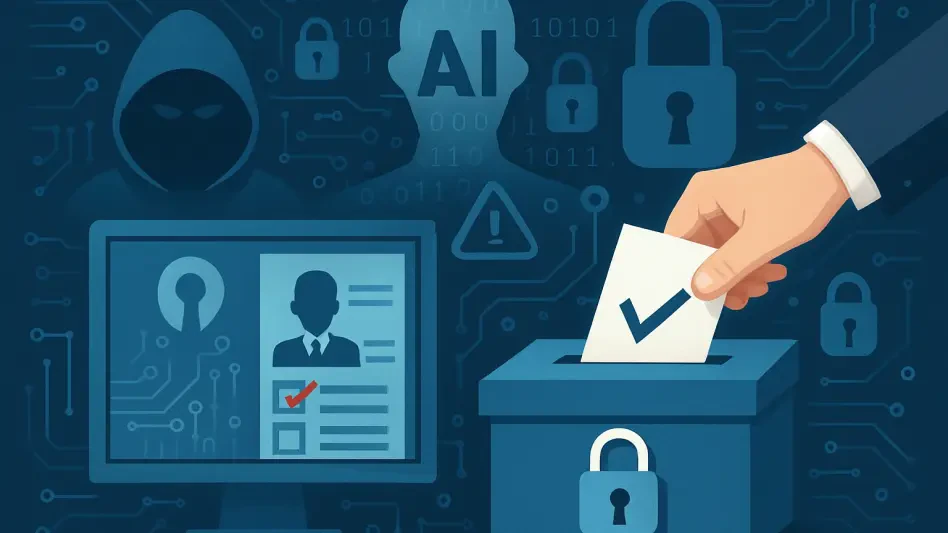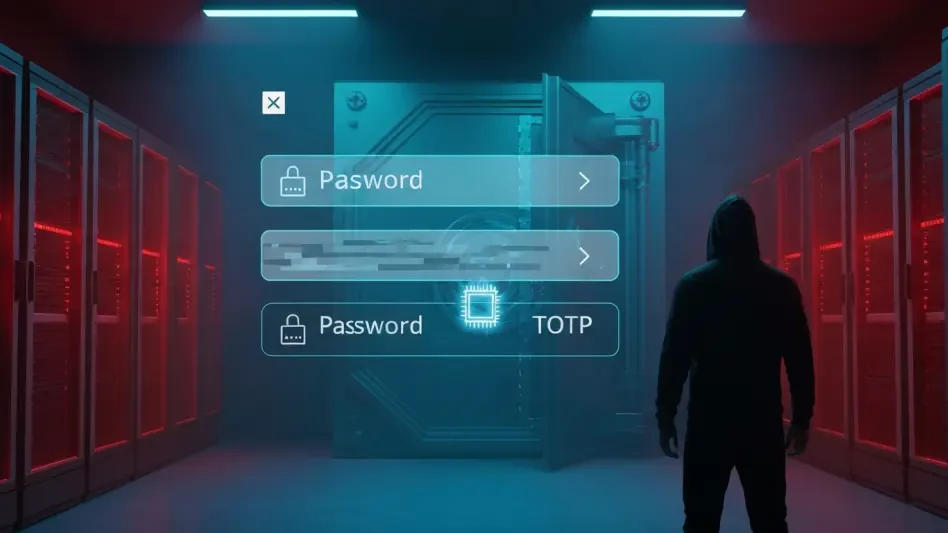In an era where digital infrastructure underpins nearly every facet of society, the surge in cyber threats has become a pressing concern for governments, businesses, and individuals alike, with recent incidents exposing vulnerabilities from election systems to artificial intelligence applications. This week alone, the cybersecurity landscape has been rocked by a series of alarming events that highlight the fragility of digital defenses across multiple sectors. From coordinated attacks disrupting election websites in Moldova to emergency call outages affecting thousands in Australia, the scope of these crises is staggering. Add to this the emerging risks tied to AI-driven attacks in schools and extortion schemes targeting corporate giants, and it becomes clear that the battle for digital security is intensifying. As ransomware groups grow bolder and legal battles over surveillance misuse unfold, the need for robust protections and proactive strategies has never been more evident. These incidents serve as a stark reminder of the interconnected risks facing the modern world.
1. Election Disruptions in Moldova
The digital assault on Moldova’s election infrastructure stands as a chilling example of how cyberattacks can undermine democratic processes during critical times. Over 4,000 websites tied to voting and election information were taken offline in a wave of politically charged disruptions. Amid heightened tensions, authorities scrambled to address the chaos as investigators pinpointed coordinated traffic spikes aimed at servers hosting voter data portals. Security teams swiftly deployed mitigation strategies, working tirelessly to restore access and fortify systems against further interference. This incident underscores the vulnerability of public-facing digital assets during politically sensitive periods, raising questions about the readiness of nations to counter such targeted campaigns. As monitoring continues, the focus remains on ensuring that future electoral events are shielded from similar threats through enhanced cybersecurity measures and international cooperation.
Beyond the immediate impact on Moldova, this attack signals a broader trend of cyber warfare tactics being wielded to influence political outcomes globally. The scale of the disruption—thousands of sites incapacitated in a short span—demonstrates the sophistication and intent behind these operations. Such events are not merely technical failures but deliberate attempts to erode public trust in democratic institutions. While services have been largely restored, the incident has prompted discussions on the need for resilient infrastructure capable of withstanding sudden, high-volume attacks. Governments worldwide are now urged to reassess their digital defenses, particularly for systems integral to civic participation. The Moldova case also highlights the importance of real-time threat detection and rapid response mechanisms to minimize damage. As cybercriminals refine their methods, staying ahead requires not just technology but also strategic foresight and cross-border collaboration to protect the integrity of elections.
2. Telecom Outages and Emergency Failures at Optus
In Australia, a significant outage at Optus disrupted emergency call services for 4,500 customers, exposing critical gaps in telecom reliability during urgent situations. The incident, which halted access to vital communication lines, triggered a federal probe into the root causes and broader implications for public safety. While the company managed to restore services within hours and issued a public apology, the event has raised serious concerns about network redundancy and the dependability of emergency systems. Regulators have demanded comprehensive reports detailing the failure and the steps taken to prevent recurrence, emphasizing that such disruptions are unacceptable in a connected society. This case serves as a wake-up call for telecom providers to prioritize infrastructure resilience, especially for services that can mean the difference between life and death.
The fallout from the Optus outage extends beyond immediate service restoration, as it has ignited a broader debate on accountability and preparedness in the telecommunications sector. With thousands unable to reach emergency responders during the disruption, the incident highlights the potential consequences of system failures in high-stakes scenarios. Australian authorities are now pushing for stricter oversight and enhanced protocols to ensure that telecom networks can handle unexpected surges or attacks without compromising critical functions. For consumers, this event is a stark reminder of the reliance on digital systems for safety and the need for providers to maintain robust backup plans. As investigations unfold, the focus is on identifying whether this was a preventable error or a sign of deeper systemic issues. The outcome of this probe could set precedents for how telecom failures are addressed, potentially reshaping industry standards for emergency communication reliability.
3. AI Security Measures by Salesforce
Salesforce has taken a proactive step to curb AI-related vulnerabilities by introducing trusted URL controls for its Agentforce and Einstein AI applications, aiming to prevent data leaks through prompt injection attacks. This new security requirement restricts AI outputs to approved domains, ensuring that sensitive information does not flow to unverified third-party endpoints. Administrators are now tasked with configuring trusted URLs for integrated workflows, a move prompted by growing reports of indirect data exposure risks. The company has provided detailed instructions for setup, urging customers to validate their deployments to maintain secure operations. This update reflects a broader recognition of the unique challenges posed by AI tools in enterprise environments, where unchecked outputs can inadvertently compromise confidential data.
To assist with implementation, Salesforce has outlined a clear step-by-step process for configuring trusted URLs: First, access security settings by logging into the Salesforce admin panel and navigating to the security or app settings section. Next, locate the trusted URL configuration option under AI or integration workflows. Then, define approved domains by entering the list of verified URLs that AI outputs should be restricted to. After that, save and validate changes by applying the settings and testing the configuration to ensure workflows operate within specified domains. Finally, monitor and adjust by regularly reviewing logs and updating the trusted URL list as needed to address emerging risks or new integrations. This structured approach aims to minimize misconfigurations and enhance protection. As AI adoption accelerates, such measures are crucial for balancing innovation with security, ensuring that businesses can leverage advanced tools without exposing themselves to preventable breaches.
4. AI-Driven Threats in Educational Institutions
A recent report has unveiled a troubling statistic: 41% of schools in the US and UK have encountered AI-related cyber incidents this year, ranging from deepfake content to generative phishing and unauthorized data scraping. These attacks exploit gaps in digital controls, compounded by insufficient staff training and lax oversight of student AI usage. The proliferation of such threats in educational settings reveals how emerging technologies can be weaponized against vulnerable institutions with limited resources for defense. Schools are now racing to implement AI filters and expand digital ethics programs to educate both students and faculty on safe technology use. Meanwhile, governments are considering tighter regulations to govern classroom tech, aiming to strike a balance between innovation and security in learning environments.
The impact of these AI-driven incidents on schools extends beyond immediate breaches, as they erode trust in digital tools that are increasingly integral to education. Deepfake content, for instance, can be used to spread misinformation or harass individuals, while phishing schemes tailored by AI pose risks to sensitive data like student records. The lack of robust safeguards has left many institutions exposed, prompting a shift toward proactive measures. Beyond technical filters, there is a growing emphasis on fostering a culture of digital responsibility among students and educators. Policymakers face the challenge of crafting guidelines that protect without stifling the benefits of AI in teaching. As these threats evolve, educational systems must adapt by investing in both technology and training to safeguard their communities. This situation underscores the urgent need for tailored cybersecurity frameworks that address the unique risks faced by schools in a rapidly digitizing world.
5. Extortion and Ransomware Tactics Targeting Corporates
Corporate giants are not immune to the escalating audacity of cybercriminals, as evidenced by Google’s report of extortion emails sent to executives following an alleged Cl0p-linked breach of Oracle E-Business Suite. These messages, citing internal business details for credibility, threatened data leaks unless demands were met, showcasing the sophisticated intimidation tactics employed by attackers. Google has advised verifying sender identities, reporting suspicious communications, and bolstering DMARC and authentication controls to counter impersonation attempts. Meanwhile, the Medusa ransomware group reportedly tried recruiting a BBC journalist for insider access, illustrating the lengths to which malicious actors will go to infiltrate organizations. These incidents highlight the persistent and evolving nature of ransomware threats in the corporate sphere.
Elsewhere, the Scattered LAPSUS$ Hunters ransomware group has launched a new data leak site after prior domains were shut down, listing fresh victims from Europe and South America alongside proof of stolen files. Researchers noted similarities to earlier LAPSUS$-linked portals, with recent timestamps indicating active campaigns. Such developments reflect the relentless adaptability of ransomware operators, who continue to exploit vulnerabilities despite law enforcement efforts. The combination of extortion, insider recruitment, and public data leaks creates a multi-pronged threat that challenges even the most fortified enterprises. Companies must prioritize advanced threat detection and employee awareness to mitigate these risks. As investigations into these incidents progress, the corporate sector is reminded of the importance of layered defenses against an enemy that exploits both technology and human psychology to achieve its goals.
6. Legal and Ethical Battles in Cybersecurity
Legal ramifications of cybersecurity misuse have come to the forefront with California Attorney General Rob Bonta filing a lawsuit against the city of El Cajon and its police department for alleged violations involving the Flock Safety license plate reader system. The complaint claims officers conducted database searches for agencies across 26 states, breaching state law. Seeking an injunction and legal clarity, the suit aims to halt such practices, though the El Cajon Police Department has yet to respond. This case raises critical questions about the boundaries of surveillance technology and the balance between public safety and privacy rights. As digital tools become more pervasive in law enforcement, ensuring their use aligns with legal and ethical standards remains a contentious issue that demands clear guidelines.
On a different note, public backlash forced a rare retreat by hackers from the Radiant group, who claimed to have deleted children’s data stolen from the UK-based Kido nursery chain after widespread criticism. Kido, following law enforcement guidance, refused to pay ransom and continues working with authorities to confirm permanent data deletion. This incident, verified by the BBC as no longer visible on the hackers’ leak site, demonstrates the power of societal pressure in influencing cybercriminal behavior. However, it also underscores the vulnerability of sensitive personal data in sectors like childcare, where breaches can have profound emotional impacts. These contrasting cases—legal action against misuse and ethical victories through public outcry—illustrate the multifaceted nature of cybersecurity challenges, where technology, law, and morality intersect in complex ways.
7. Rising Reconnaissance and Scanning Activities
GreyNoise has reported a staggering 500% surge in IPs scanning Palo Alto Networks login portals, marking the highest activity level in 90 days with over 1,300 unique IPs flagged as suspicious. Concentrated in the US and several European regions, this spike has analysts on high alert to determine whether it indicates specific vulnerabilities or serves as reconnaissance for future attacks. Such scanning activity often precedes more targeted exploits, making early detection and analysis critical to preempting larger threats. The sheer volume of IPs involved suggests a coordinated effort, potentially by multiple threat actors probing for weaknesses in widely used systems. Organizations relying on Palo Alto Networks are advised to monitor their environments closely and apply patches or updates as necessary to mitigate risks.
The implications of this scanning surge extend to the broader cybersecurity community, as it reflects the persistent efforts of malicious actors to map out attack surfaces across industries. While the intent behind the activity remains under investigation, the focus on login portals—a common entry point for unauthorized access—signals a need for heightened authentication measures and intrusion detection systems. Companies must also consider the possibility of insider threats or compromised credentials fueling these scans. The concentration of activity in specific geographic areas could point to localized threat groups or infrastructure being leveraged for malicious purposes. As GreyNoise continues to track these patterns, the incident serves as a reminder that vigilance and proactive defense are non-negotiable in an era where digital reconnaissance can quickly escalate into devastating breaches. Staying ahead of such threats requires constant adaptation and robust security postures.
8. Navigating the Future of Digital Defense
Reflecting on the myriad cybersecurity incidents that unfolded, it became evident that threats spanned across critical sectors—elections, telecom, education, corporate environments, and law enforcement—each revealing unique vulnerabilities that demanded tailored responses. The disruptions in Moldova’s election systems and the Optus outage exposed the fragility of essential public services, while AI-driven attacks in schools highlighted the unintended consequences of rapid tech adoption. Legal battles over surveillance misuse and ethical wins against data thieves further illustrated the complex interplay of technology, policy, and societal values in shaping digital security.
Looking ahead, actionable steps emerged as vital to strengthening defenses against an ever-evolving threat landscape. Organizations were encouraged to prioritize real-time threat monitoring, invest in employee training, and adopt advanced authentication protocols to counter sophisticated attacks. Governments and industries needed to collaborate on establishing clearer regulations for emerging technologies like AI, ensuring innovation did not outpace security. By learning from these crises, stakeholders could build more resilient systems, fostering a digital environment where trust and safety were paramount for future progress.








